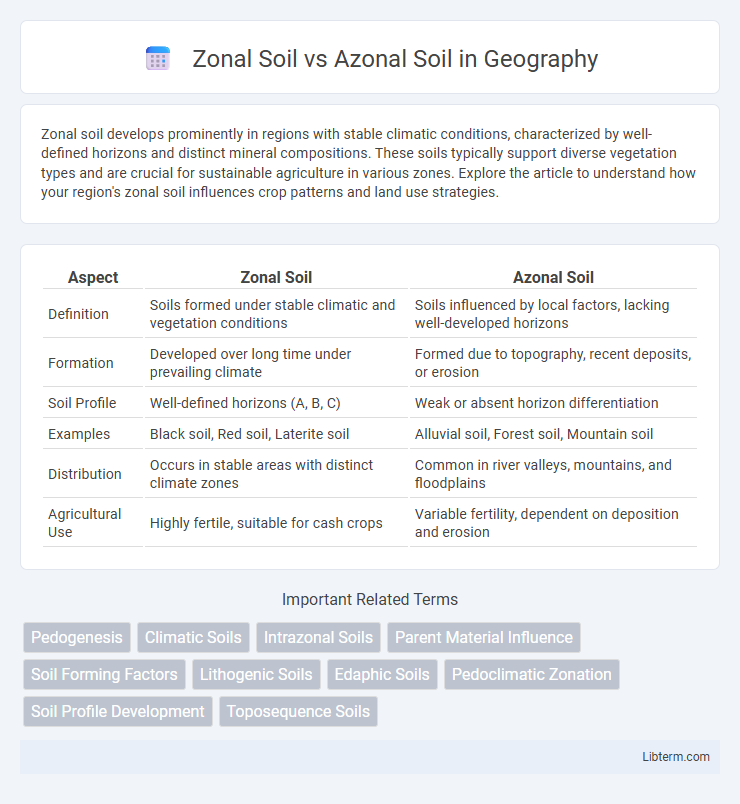Zonal soil develops prominently in regions with stable climatic conditions, characterized by well-defined horizons and distinct mineral compositions. These soils typically support diverse vegetation types and are crucial for sustainable agriculture in various zones. Explore the article to understand how your region's zonal soil influences crop patterns and land use strategies.
Table of Comparison
| Aspect | Zonal Soil | Azonal Soil |
|---|---|---|
| Definition | Soils formed under stable climatic and vegetation conditions | Soils influenced by local factors, lacking well-developed horizons |
| Formation | Developed over long time under prevailing climate | Formed due to topography, recent deposits, or erosion |
| Soil Profile | Well-defined horizons (A, B, C) | Weak or absent horizon differentiation |
| Examples | Black soil, Red soil, Laterite soil | Alluvial soil, Forest soil, Mountain soil |
| Distribution | Occurs in stable areas with distinct climate zones | Common in river valleys, mountains, and floodplains |
| Agricultural Use | Highly fertile, suitable for cash crops | Variable fertility, dependent on deposition and erosion |
Introduction to Zonal and Azonal Soils
Zonal soils develop under the influence of climate and vegetation typical of specific geographic zones, reflecting the dominant environmental conditions. Azonal soils lack distinct horizon development and are usually found in areas with recent soil formation or disrupted soil profiles. Understanding these soil categories helps in assessing soil fertility and land-use suitability in diverse ecological regions.
Definition of Zonal Soil
Zonal soils develop under the direct influence of climate and vegetation, representing the mature stage of soil formation in a specific geographic zone. These soils reflect the predominant climatic conditions and vary significantly across different climatic regions, such as tropical, temperate, or polar zones. In contrast, azonal soils show minimal horizon development and are often influenced by local factors like topography or parent material rather than climate.
Characteristics of Zonal Soil
Zonal soils develop under specific climatic and vegetation conditions, exhibiting distinct layers with well-defined horizons and strong profile development. These soils are typically mature, showing pronounced physical and chemical properties influenced by long-term weathering and organic matter accumulation. Examples include lateritic and chernozem soils, known for their fertility and suitability for agriculture.
Definition of Azonal Soil
Azonal soil refers to soil types that have not fully developed distinct horizons due to factors like topography or recent deposition, resulting in immature or poorly differentiated profiles. These soils are often found in areas with unstable environments such as riverbanks, floodplains, or regions affected by erosion or deposition. In contrast, zonal soils are well-developed, mature soils that reflect the climatic and vegetative conditions of a specific geographic zone.
Characteristics of Azonal Soil
Azonal soils exhibit minimal profile development due to active erosion, deposition, or recent formation, often found in floodplains, deserts, and slopes. These soils typically lack distinct horizons and display properties dominated by parent material rather than climate or vegetation. Common characteristics include high variability, poor nutrient retention, and limited organic matter accumulation compared to well-developed zonal soils.
Key Differences Between Zonal and Azonal Soils
Zonal soils develop under the direct influence of climate and vegetation, displaying well-defined horizons and mature characteristics, while azonal soils are young, poorly developed, and influenced by local factors such as topography rather than climate. Zonal soils include types like red, black, and laterite soils, reflecting long-term weathering and soil formation processes; azonal soils consist of alluvial, floodplain, and forest soils, often showing irregular distribution with little horizon differentiation. The main difference lies in zonal soils representing stable, climatically controlled zones, whereas azonal soils are transitional or secondary formations with minimal profile development.
Factors Influencing Zonal Soil Formation
Zonal soils develop under the direct influence of the dominant climate of a region, with temperature and precipitation patterns playing crucial roles in their formation and characteristics. Vegetation type, parent material, and time contribute to the soil horizon development, but climate remains the primary factor distinguishing zonal soils from azonal soils, which lack well-developed horizons due to less climatic influence. The strong interaction of climate, biota, relief, parent material, and time defines zonal soil profiles, resulting in distinct soil orders such as laterites, chernozems, and podzols.
Factors Influencing Azonal Soil Formation
Azonal soils form primarily due to disturbances in the soil profile influenced by factors such as recent geological activity, parent material composition, and climatic conditions that prevent full soil profile development. Unlike zonal soils, which develop distinct horizons from prolonged weathering and stable climate, azonal soils often exhibit characteristics of young or immature soils, including minimal horizon differentiation. Hydrological conditions like frequent flooding or erosion also play a significant role by redistributing soil materials, thus inhibiting horizon formation in azonal soils.
Geographic Distribution of Zonal and Azonal Soils
Zonal soils develop over large geographic areas and reflect the prevailing climate and vegetation of a region, typically found in temperate, tropical, and boreal zones such as Chernozem in Eurasian steppes, laterite in tropical regions, and podzols in boreal forests. Azonal soils occur in localized areas where soil formation is influenced by recent geological processes or topographic conditions, such as alluvial soils in river valleys, floodplains, and desert soils in arid zones. Zonal soils dominate stable landscapes with mature soil profiles, whereas azonal soils are prevalent in dynamic environments with frequent deposition or erosion.
Importance of Understanding Zonal vs Azonal Soils
Zonal soils, formed under stable climate conditions and mature landscapes, are crucial for sustainable agriculture and ecosystem balance, reflecting long-term climatic influences. Azonal soils, often found in areas with recent geological activity or unstable conditions, play a key role in land reclamation and early succession habitats due to their varied composition and development stages. Understanding the differences between zonal and azonal soils enables better land use planning, soil conservation strategies, and efficient resource management aligned with environmental and agricultural needs.
Zonal Soil Infographic

 libterm.com
libterm.com